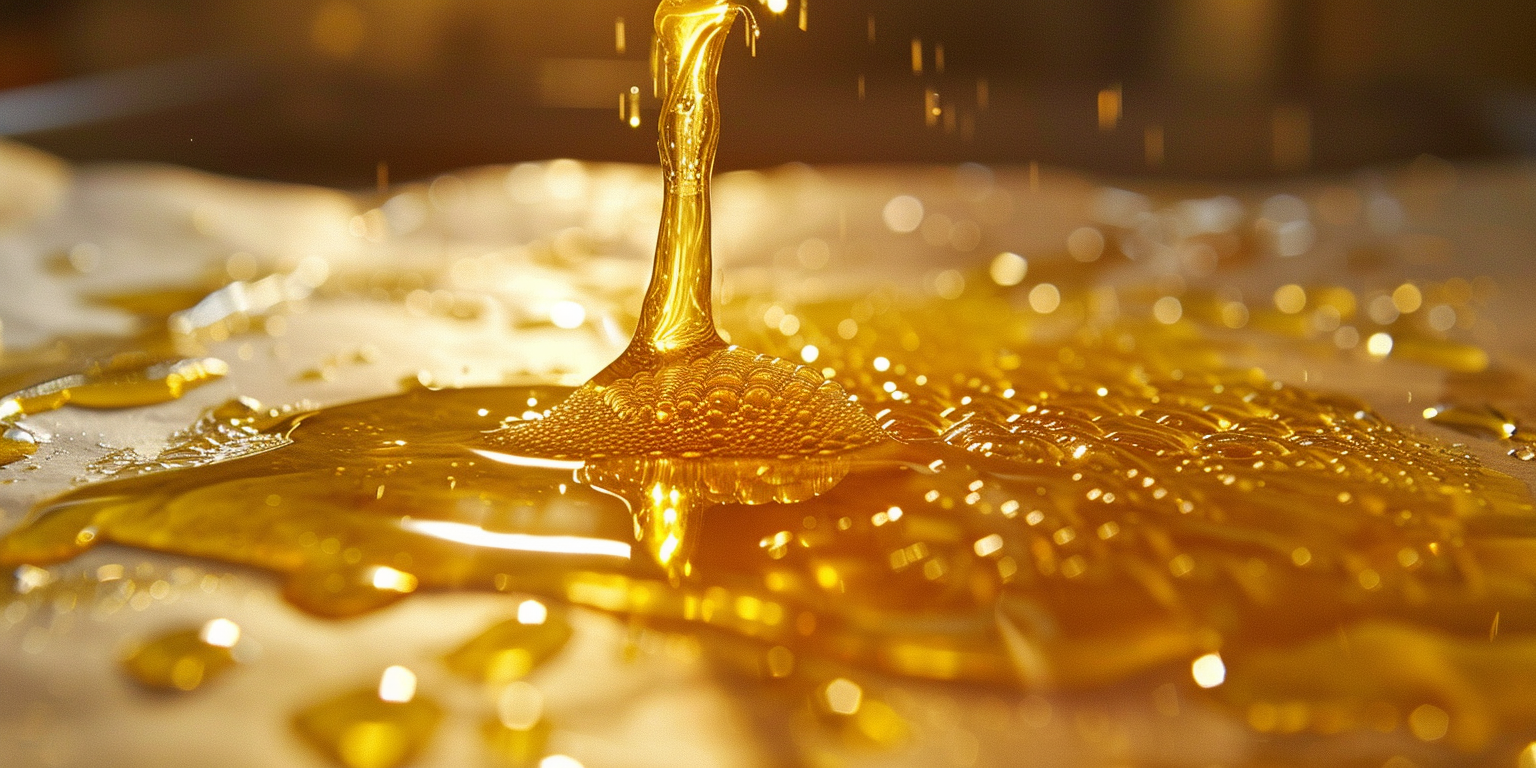Introduction
Dry Herb concentrates have surged in popularity, offering users a potent and refined form of marijuana. This article will provide an overview of dry herb concentrates, delve into the specifics of rosin, explore its various forms, and discuss why concentrates are becoming a preferred choice for many dry herb consumers.
Overview of Dry Herb Concentrates
What Are Concentrates?
Concentrates are highly potent forms of dry herb derived from the Dry Herb flower. The extraction process isolates essential compounds like cannabinoids, flavonoids, and terpenes. The result is a product with significantly higher concentrations of these bioactive compounds.

To give an example, the dry herb flower itself typically has THC levels ranging from 10% to 35%, depending on the strain and growing conditions. In stark contrast, concentrates can boast THC levels between 50% and 90%. This dramatic difference in potency means that even a small amount of concentrate can deliver a powerful effect.
This heightened potency is one of the primary reasons there has been a surge in the popularity of concentrates. As more consumers chase new ways to achieve different highs, the appeal of concentrates continues to grow. Whether for recreational or medicinal purposes, the intense effects of these products cater to those seeking a more robust and efficient dry herb experience. Furthermore, the increased availability of concentrate-specific tools and products makes it easier than ever for users to explore and enjoy these potent forms of dry herb.
This surge in popularity is supported by the ever-evolving methods of extraction. Each method is designed to maximise the potency and purity of the final product. Understanding these methods is crucial for appreciating the variety and quality of dry herb concentrates available today.
Methods of Extraction
Historically, extraction methods were quite rudimentary, often involving simple techniques. Dry sifting or using basic tools to separate trichomes from the dry herb plant for example. These early methods laid the foundation for more advanced techniques.
As technology and understanding of dry herb chemistry evolved, so did the methods of extraction, becoming more sophisticated and efficient. This evolution has led to the development of more precise and effective extraction techniques.
Currently, there are two main methods of extracting concentrates: solvent-based and solventless extraction.
- Solvent-Based Extraction: This method uses chemical solvents like butane, propane, ethanol, or CO2 to dissolve the trichomes from the dry herb material. The resulting mixture is then purged to remove residual solvents. Examples include wax, crumble, budder, and shatter.
- Solventless Extraction: This method uses mechanical agitation, ice water, heat, and pressure to separate the trichomes without chemical solvents. It is considered a safer and more natural method. Common solventless concentrates include rosin, hash rosin, and bubble hash.
In-Depth Look at Rosin
What is Rosin?
Rosin is a dry herb concentrate made using heat and pressure to extract cannabinoids and terpenes from the plant material. Unlike solvent-based concentrates, rosin is produced without chemical solvents, making it a preferred choice for those seeking a more natural product. This solvent-less extraction process preserves the full spectrum of cannabinoids and terpenes, resulting in a product that offers a robust and rich flavour profile.
One of the main benefits of rosin is its purity. Since no chemicals are used in the extraction process, consumers can enjoy a cleaner and potentially safer experience. Additionally, rosin can be produced at home with relatively simple equipment, making it accessible for both newcomers and seasoned dry herb enthusiasts. This accessibility also means that enthusiasts can experiment with different strains and extraction techniques, tailoring their experience to their personal preferences.
Production Process
Rosin production is easier than ever, thanks to the accessibility of modern rosin presses. Personal rosin presses, such as the Dulytek range, offer great options for both beginners and experienced users. If you want to try producing your own rosin, the process is straightforward:
- Preparation: Select high-quality dry herb flowers, hash, or kief. If using flowers, ensure they are properly dried and cured to optimise the yield and quality of the rosin.
- Pressing: Place the dry herb material between parchment paper and apply heat and pressure using a rosin press. The combination of heat and pressure extracts the cannabinoids and terpenes, creating a sticky, resinous substance. Modern rosin presses are designed to be user-friendly and efficient, making the process accessible to anyone interested in making their own rosin.
- Collection: Once pressed, the rosin is collected from the parchment paper. It can be used immediately or stored for later use. The simplicity of this method means you can produce high-quality rosin at home with minimal equipment and effort.
Types of Rosin

- Fresh Press Rosin: Transparent and homogeneous, fresh press rosin is stored in the freezer to maintain its consistency and is known for its potent flavour and aromatic profile. This type of rosin is a great option for those who value purity and the full spectrum of terpenes and cannabinoids. It’s ideal for immediate use due to its delicate nature, making it perfect for connoisseurs who appreciate a fresh, unadulterated dry herb experience. Fresh press rosin is relatively easy to produce, requiring careful handling and storage.
- Rosin Badder (Butter): Creamy and opaque, rosin badder is created by mixing and agitating fresh press rosin. It has a thick, stable consistency that is easier to handle and does not require refrigeration. This makes it a convenient choice for users who prefer a manageable and long-lasting product. The creamy texture allows for easy dosing and application, making it suitable for both beginners and experienced users. Creating rosin badder involves an additional step of whipping or mixing, but it’s straightforward and can be done with minimal equipment.
- Rosin Jam (Sauce): This form of rosin has a runny base with sugar-like crystals, achieved through warm curing. It combines a potent extract with a unique texture and flavour. Rosin jam is ideal for users looking for a robust and flavorful experience, as the warm curing process enhances the terpene profile. The unique texture offers a distinct dabbing experience, appealing to those who enjoy experimenting with different consistencies. Producing rosin jam requires precise control of temperature and curing time, making it a bit more advanced than other forms, but the results are highly rewarding for those willing to invest the effort.
The Evolution and Popularity of Concentrates
Historical Use and Modern Surge
Dry Herb concentrates have been around since the early 20th century, but their popularity has skyrocketed in recent years with the growth of the marijuana industry. Early adopters, often well-versed in technology and science, embraced these potent forms of dry herb for their efficiency, convenience, and customizable experiences.
Medical Benefits and Recreational Appeal
The medicinal benefits of dry herb concentrates are a major factor in their popularity. Patients suffering from chronic pain or other conditions can benefit from the concentrated levels of cannabinoids found in these products. Concentrates provide higher doses of cannabinoids than flowers, making them ideal for those needing strong medication. Additionally, recreational users appreciate the potent effects and variety of flavours concentrates offer.
Modern-Day Concentrate Consumption
Concentrates have become a preferred way to use dry herb due to their potency, convenience, and versatility. Dabbing and vaping are common consumption methods, with devices like dab rigs, vaporizer pens, and disposable vapes making it easy for users to enjoy concentrates. The reduced inhalations needed to achieve desired effects and the stronger, longer-lasting effects are appealing to many consumers.
Why You Should Consider Trying Concentrates
Advantages Over Traditional Flower
- Potency: Concentrates offer much higher concentrations of cannabinoids and terpenes, providing stronger and quicker effects than traditional flower.
- Efficiency: A small amount of concentrate can provide the desired effects, making it a cost-effective option over time.
- Variety: With many forms available, from wax and shatter to rosin and bubble hash, consumers have a wide range of options to choose from based on their preferences.
Getting Started with Concentrates
Start Small: Begin with a small amount, about the size of a rice grain, especially if you are new to concentrates.
Choose Your Method: Decide whether you want to dab, vape, or use a concentrate pen. Each method has its own benefits and equipment requirements.
Explore Different Types: Try various forms of concentrates to find what suits you best. Rosin, with its natural extraction process and potent effects, is an excellent starting point.
Conclusion
The rise of dry herb concentrates, particularly rosin, marks a significant development in the dry herb industry. With its high potency, variety of forms, and natural production methods, rosin offers a compelling option for those seeking a pure and powerful dry herb experience. As concentrates become more accessible and popular, consumers can enjoy the benefits of these potent products with confidence and ease.
With the growing availability of rosin extraction equipment and accessories, such as presses and collection tools, getting started with rosin has never been easier. Investing in quality tools can enhance the extraction process, ensuring you achieve the best possible results. Whether for medicinal purposes or recreational enjoyment, rosin offers a versatile and rewarding way to experience dry herb.
Whether you’re new to concentrates or looking to explore new options, rosin provides a versatile and enjoyable way to elevate your dry herb consumption.

